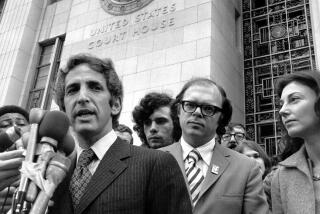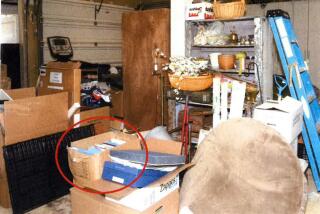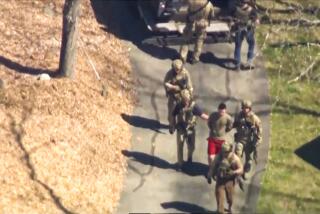Arduous Dig to Find Spyâs Buried Stash
WASHINGTON â The secret government documents and clues to their whereabouts were bundled into garbage bags, stuffed into Tupperware containers, even squeezed into a purple plastic salt shaker. Then, the would-be spy hid them in parks in Maryland and Virginia, using his expertise in global satellite positioning to keep tabs on his ill-gotten stash.
Authorities say former Air Force Master Sgt. Brian Patrick Regan concocted the elaborate concealment system in his efforts to spy for Iraq and China more than three years ago. Now Regan, a former intelligence analyst for the Defense Department who was convicted of attempted espionage in February, is behind bars serving a life sentence without parole. And the documents -- which were scattered in 19 locations -- have all been recovered, authorities said Wednesday.
Regan, 41, and a married father of four, was an analyst in the Pentagonâs National Reconnaissance Office. He was accused, among other acts, of writing to Saddam Hussein and offering intelligence secrets in exchange for $13 million. He was convicted of trying to sell the documents to Iraq and China, but acquitted of attempting to spy for Libya.
Under a plea agreement, Regan was required to cooperate with authorities and disclose what he had done with the classified information he took, including specifics about U.S. satellite technology.
Agents from the FBI, the Department of Justice and the National Reconnaissance Office worked from March until June of this year to recover the 20,000 pages, five compact discs and five videotapes containing confidential details of military secrets. The documents, packaged in a wide variety of containers, were buried at 12 remote sites in Pocahontas State Park a few miles south of Richmond, Va., and at seven sites in Marylandâs Patapsco Valley State Park near Baltimore, officials said.
âThrough interrogations, weâre confident that we found everything,â said Ron Nesbitt, the FBI special agent in charge of counterintelligence at the Washington field office. The documents, piled on a table in seven boxes and 10 paper bags at a news conference Wednesday, were well-preserved, Nesbitt said.
The governmentâs goose chase began when Regan told agents about a green plastic toothbrush holder and purple plastic salt shaker, each with encoded locations of the 19 buried bundles, said U.S. Atty. Paul J. McNulty. The toothbrush holder and salt shaker, wrapped in plastic and brown packing tape, were hidden in underbrush near exit ramps off Interstate 95, between Washington and Richmond.
Regan then helped investigators to break the code he had created -- and later forgot -- to obscure the global positioning system coordinates of his hiding spots. The Virginia sites were discovered easily. âWe recovered 12 out of 12 packages in rapid order,â said Steve Carr, an FBI special agent. The Maryland codes were more difficult to crack, taking about a month to decipher, Carr said.
But the coordinates only narrowed down each of the rural locations to a 25-foot area, said Frank Shults, the chief of liaison for the U.S. attorneyâs office. Reganâs scheme then incorporated special markings on trees six feet away from the 18-inch-deep burial sites. Officials would not elaborate on the nature of the markings, but said they had been removed.
The planâs complexity demonstrated âthe extent to which [Regan] had prepared and was willing to goâ in revealing classified information, McNulty said. âThe locations were not easily seen by anybody.â
Agents searching for the packages had to contend with rough, isolated terrain. In âVirginia ... just walking into the area was difficult,â said FBI Special Agent Lydia Jechorek. The agents had particular trouble negotiating the hilly Maryland parkland crisscrossed with streams swelled by spring rains.
Patricia Haynes, an assistant U.S. attorney who went on one of the search missions, said conditions were âhorrible -- there were mosquitoes, bugs, ticks, and it was very hilly.â
Searchers âkept going out there and not getting anythingâ said Air Force Col. Debra Donahoo, the chief intelligence officer for counterintelligence at the National Reconnaissance Office. âThe idea that they kept on digging when they were hitting just dirt was extremelyâ impressive, she said. Regan accompanied agents to the Maryland park three times to help them find the documents.
Regan was arrested Aug. 23, 2001, at Washingtonâs Dulles International Airport attempting to board a flight to Zurich, Switzerland. Officials believe he was on the verge of negotiations with foreign governments.
More to Read
Sign up for Essential California
The most important California stories and recommendations in your inbox every morning.
You may occasionally receive promotional content from the Los Angeles Times.










